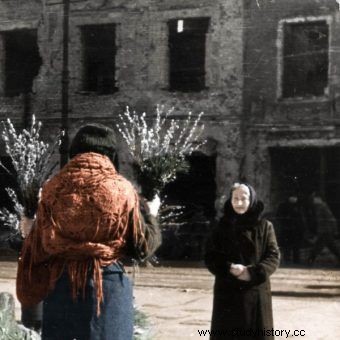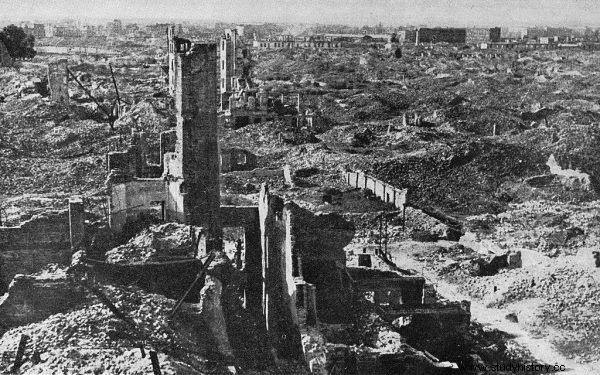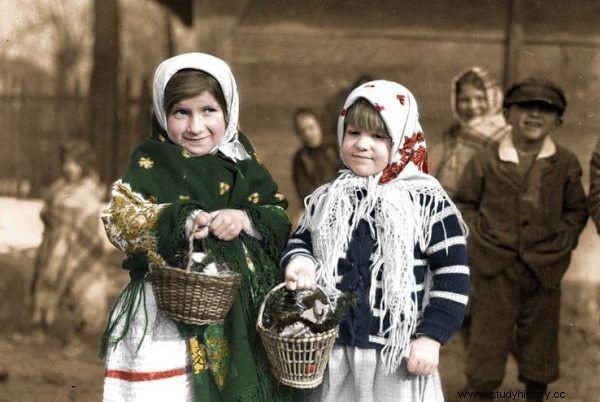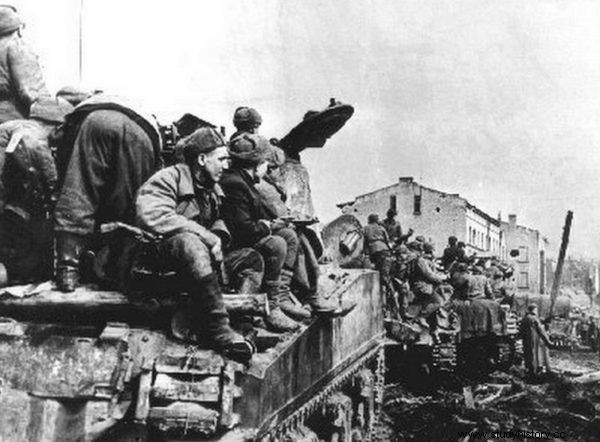The inhabitants of Kresy were leaving their homeland. Varsovians were returning to their ruined houses. But even in these uncertain times, there was no question of Easter without Easter eggs. And the Christmas breakfast, even if the ham was replaced by ... Soviet canned food.
Easter Sunday in 1945 fell on April 1, i.e. April Fool's Day. The images that emerge from the memories of witnesses of those days, however, do not evoke any merriment. Fighting continued in some areas. Almost everything was missing in the liberated areas.
Although efforts were made to maintain Easter traditions, despite the scarcity, the festive tables were modest. Sometimes the white tablecloth was replaced by a sheet. The treat consisted of eggs, horse meat or a Soviet carcass, i.e. canned meat. Only a few could afford dough, ham or sausage.

Easter base in ruined Warsaw.
People's moods were mixed. Some were happy with the liberation, but there were also Poles who had already understood what "liberation" by the Red Army really meant.
Wojciech Braun, who spent Easter in 1945 in Nowy Dwór Mazowiecki, especially remembered the Resurrection Mass. During the ceremony, when "God's something, Poland" was chanted, some people expressed their objection by changing the words of the song. Instead of bless the Motherland, Lord they sang: Please give us a free homeland, Lord. This slight but telling accent turned the Catholic rite into a political demonstration.

The image of Warsaw in 1945 did not inspire celebration.
Despite the approaching end of the war, the feast of 1945 cannot be called peaceful. A family from Trościaniec Wielki in Podolia found Easter ... on the railway ramp . She was displaced in January 1945, but the journey from Kresy to the new destination took many months. Despite unfavorable circumstances, a group of travelers managed to organize at least a substitute for the customary celebrations. They were allowed to attend a holy mass in a nearby town. Each of the family members received a sacred egg from the priest. They even ate a small Easter breakfast consisting of food donated by random people.
Candy divided into several parts
In the spring of 1945, anxiety was everywhere. In many places, the escaping Germans were immediately replaced by the Russians. The experiences acquired during those first contacts between Poles and Soviet soldiers were extremely different. And certainly not always positive. This is how the entry of the Red Army is described by Dariusz Kaliński in his book “Czerwona Zaraza. How did the liberation of Poland really look like? ”:
In the spring of 1945, many acts of violence against our compatriots by Soviet soldiers took place. Trains and private houses were attacked, entire villages were plundered. In the liberated territories, the settlers abandoned their post-German homes and fled in panic to central Poland .
Edelgard Hanowski, a resident of Warmia, recalls a bad entry by the Soviets. Red Army soldiers reached his town just before Easter. He himself with his family fled to the forest upon the news of the approaching army. He didn't come home until Christmas. However, he found a looted farm. The Russians even killed his dog.
Is it possible to even think about celebrating in such difficult and uncertain conditions? Despite poverty and fear, many Poles organized traditional attractions with their children in mind. They were even given symbolic gifts! The youngest were given an egg and a piece of candy or drops. The hard-to-reach sweets were divided into several parts to bestow as many people as possible . Helpful neighbors put food for the family holiday breakfast in the baskets of children from the poorest families.
New cleanup
The holidays of the Home Army soldiers were going to be particularly uninteresting. With the entry of the Soviets into Poland, the first arrests began. The repressions of the Home Army in Lviv suffered from repressions in the summer of 1944. A few months later, in November, the NKVD established a camp for them in Skrobów near Lubartów. However, the imprisoned Poles did not intend to spend Easter there.

Before Easter 1945, many towns and villages were plundered by the Soviets. Despite this fact, the inhabitants of these places tried to cultivate their traditions.
At the end of March 1945, as many as 48 prisoners managed to escape. This is what one of the escapees, Tadeusz Czajkowski, recalls:
Soon after we left the camp, a gigantic manhunt started. It was attended by barrier units of the Red Army, NKVD, UB and MO officers. One of its members was a squadron of the Soviet cavalry. Kukuruźniki planes were tracking us, where we could pass despite the spring thaw, armored cars were chasing us.
The fugitives have already spent their holidays at large. Some of them found hospitality with random families in the village of Blizocin. They were welcomed and hosted as heroes. It was, however, only a brief respite. On Easter Monday, the soldiers thanked their hosts and headed for the partisan trail.

Red Army units after Landsberg was seized. later renamed Gorzów Wielkopolski. January 1945.
The first Polish holidays in the Recovered Territories were also exceptional. In the spring of 1945, the Polish administration was introduced there. And so, Landsberg was slowly changing into Gorzów Wielkopolski. Florian Kroenke, the first post-war staroste. mentions that the first Poles came to Gorzów at the end of March 1945. At that time, there were 30,000 German people in the city. Families soon to be displaced celebrated Easter alongside those who had just arrived to take their places.
Resurrection Festival in post-war Warsaw
And what were the first post-war holidays like in the city that survived the Holocaust? Warsaw was in ruins. Heaps of broken bricks and concrete, remnants of furniture and rubbish were temporarily scooped up the sides of the streets. They reach several meters. It is impossible to take them away - Magdalena Grzebałkowska, a reporter, describes the post-war capital city. But life was returning to the ruins. Merchants were selling Easter palms around the remains of a demolished church.
The ruined capital lacked everything:a place to sleep, bread, eggs. Food was brought from towns near Warsaw. The Różycki market in Praga was also well stocked. This is where Warsaw residents did their Christmas shopping.
The prices were high, so the Christmas menu was rather modest. The meal consisted of potatoes and horse meat. A real treat was a couple of slices of ham. With the money borrowed from our cousin, we bought a few eggs and a bunch of sausage so that it was for Easter breakfast - recalls Janina Loth-Borkowska. She herself spent the first post-war Easter with her family at her aunt's on Złota Street. There weren't even panes in the windows in the apartment where they were assembled.
However, there were also those who found themselves in an even worse situation during the holidays. However, the poorest could use the help of the “Hungry Żołądek” agency. On Easter Sunday, the help of the Supply Department was also launched, as reported by Życie Warszawy. From then on, everyone who applied was given one pork chop weighing 157.5 grams each day. People who lost their teeth received bacon.
Varsovians visited the Lord's Tomb in the Church of St. Anna, which was located on the side of Krakowskie Przedmieście, which was not destroyed by the Germans. The blessing of food took place in the ruins. After all, most of the temples on the left bank of the city were destroyed, or at least heavily damaged. The resurrection was also of an unusual nature. This is how Andrzej Korgol remembered the events of 1945:
An unforgettable impression was made by the resurrection on that holiday. Crowds of believers participated in the service and procession, there were also representatives of political organizations, administration, with banners, and a unit of Polish Army soldiers. There was also traditional shooting, but it was a real cannonade because there was still a lot of ammunition of all kinds. The army unit present at the ceremony also took part in it - only they fired at the command of their superior.

Many Poles sought peace in the churches.
Easter 1945 came at a special moment. People were just shaking off after the war years. It was also unknown what to do next. It is hard to believe that time was found in these conditions for ... Easter eggs. And yet, even at such a moment, a special setting for the holidays was taken care of. These preparations are reported by Zygmunt Kowalczykiewicz, who spent his first post-war Easter in Konin:
There must have been eggs at the post-war Easter breakfast. Those for quick eating and those for decorating the festive table. They were cooked in onion shells, in a decoction of beetroot or winter winter leaves. Gifted, they scratched different patterns with needles on colorful shells. Others painted eggs with brushes. Then they waxed them to make them shine. This responsible work was willingly performed by children.
Bibliography:
- Dariusz Kaliński, The Red Plague. What was the liberation of Poland really like? , Interesting facts Historyczne.pl 2017.
- Magdalena Grzebałkowska, 1945. War and Peace , Agora 2015
- Magda Szymańska, Returns. Warsaw 1945-46 , History Meeting House 2015.
- Zygmunt Kowalczykiewicz, The first post-war Easter , "Koniniana. Monthly magazine of the Society of Konin's Friends ”No. 3 (2013).
- Kazimierz Olender, My Easter 1944-45 , "Weekly Catholic Sunday" April 23, 2000.
- Fr. Piotr Sroga, Warmian Easter , "Sunday Guest" No. 14 (April 8, 2012).
- Tadeusz Czajkowski, A memorable Easter , Greater Poland Digital Library.
- Zbigniew Bodnar, Polish beginnings of Gorzów in 1945 in the memories of pioneers , Gorzów.com March 28, 2017.
- Jerzy S. Majewski, Tomasz Urzykowski, 70 years ago, the first free holidays were celebrated , "Gazeta Wyborcza" April 5, 2015.
- Testimony of Janina Loth-Borkowska, Banwar1944.eu.
- Heroes live next to us - Tadeusz Czajkowski - escape from Skrobów , excerpt from memoirs published in "Local History" by Bolesław Bezega, NGOpole.pl on September 28, 2011.
- "Życie Warszawy. Daily magazine ”No. 90 (1945).
